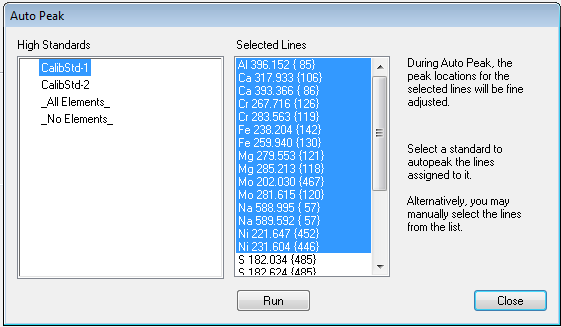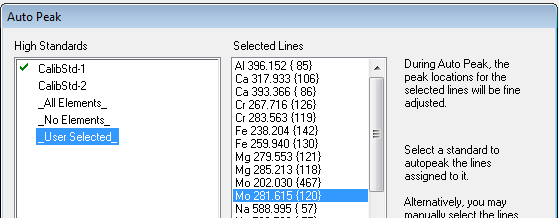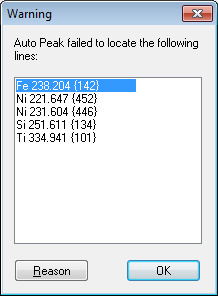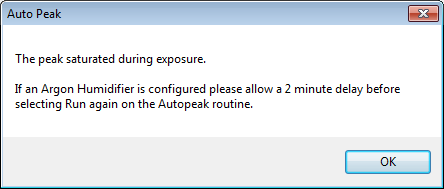Perform Auto Peak in iTEVA
Issue
Whenever a new method is created which uses a wavelength which has not been used to acquire data in another method OR a new wavelength which has not been used previously by another method to acquire data has been added to existing method, an autopeak adjust must be performed for each new wavelength.
Environment
Replace this text to add the Environment.
Resolution
1) Navigate to Instrument menu and then click on Perform Auto Peak

2) Click on the standard which contains the wavelength(s) which are to be Auto Peaked. If there are multiple standards which contain the wavelength(s) which are to be adjusted for, select the one which is the most concentrated.
If the standard you would like to use contains more wavelengths than those which are to be adjusted for, hold the <Ctrl> key and left click each wavelength you will not be adjusting for

3) Aspirate the standard you selected in step 2 and give it ample time to get into the plasma
4) Click Run
5) If the Auto Peak is successful, a green checkmark will appear next to the standard which was just ran.

6) Once the Auto Peak has been completed successfully, the center pixels may need to be adjusted. Please reference tech note: Determining the Number of Center Pixels in iTEVA
7) It is possible that some wavelengths will fail to Auto Peak. If so, the follow window will appear:

For a specific reason why each wavelength has failed to Auto Peak, click on the one of the wavelengths which have failed and then click on Reason. This will have to be done for each individual wavelength as the reasons for failure can vary.
Some potential failure responses as well as possible resolutions are as follows:

Try aspirating a single element solution which is more concentrated then the solution which as just been used to Auto Peak on. For instance, if a 1ppm standard was used, try using a 10ppm standard.

Make sure ample time was allowed for the solution to get into plasma. It might even be advisable to re-run Auto Peak due to the standard continuing to be in plasma at this point and thus should be stable. If this reason is encountered a second time, please try running a single element standard containing the element in reference to the wavelength which failed that is less concentrated than the standard which was just ran. For instance if a 10ppm standard was used, try using a 1ppm standard.

Use a single element containing the element in reference to the wavelength which failed for this reason. If this reason is encountered on a second attempt to Auto Peak, a full frame will need to be acquired to see if the subarray in reference to the wavelength which failed is touching another subarray. If it is, the subarray height or width will need to be adjusted so that it is not touching another subarray.
Analysis
Once a wavelength has been autopeak adjusted, it will typically not be required to adjust it again. However, when encountering a situation such as a change in Laboratory temperature or humidity, software reinstall, or sensitivity issue, it is advisable to perform an Auto Peak again.
Attachment(s)
| File | Last Modified |
|---|---|
| Interfering order or peak not strong enough.png | December 16, 2022 |
| Peak Saturated during exposure.png | December 16, 2022 |
| Peak Not Strong Enough.png | December 16, 2022 |
| Auto Peak Failure dialog box.png | December 16, 2022 |
| Successful Auto Peak.png | December 16, 2022 |
| Auto Peak dialog box.png | December 16, 2022 |
| Instrument menu.png | December 16, 2022 |

